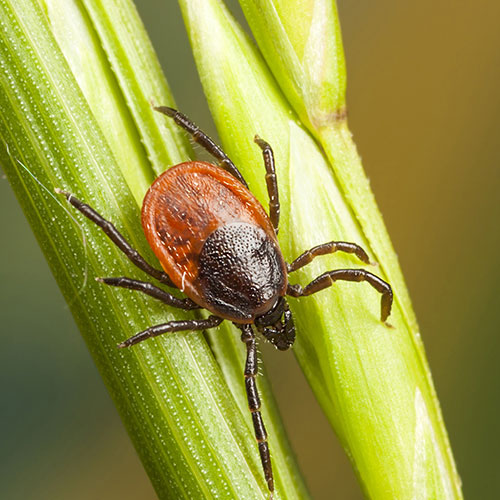FEATURED NEWS
Black-legged Tick Carrying Even More Diseases
Written By Ryan Lessard (news@hippopress.com)
Images: Courtesy/Stock Photo
Though tick numbers may have been threatened by dry weather conditions from last summer, their arsenal of pathogens has expanded with a serious virus called Powassan.
According to Alan Eaton, an entomologist with the UNH Cooperative Extension, tick populations likely suffered high mortality last summer during extreme drought conditions in southern parts of the state.
But ticks are still around. Earlier this month, Eaton searched for a few black-legged ticks for a demonstration he was giving later that afternoon and found a handful in a short span of time.

Black-legged ticks, also called deer ticks, are the kind that transmit Lyme disease, among other diseases. Adult ticks, unlike mosquitos, aren’t restricted by seasonal breeding cycles. They hibernate under snow cover during the winter but emerge to find a blood meal whenever that snow cover melts away and air temperatures rise above 40 degrees.
And before the recent drop in population, tick numbers were in a period of rapid growth. So, Eaton said, the recent drought may have just reduced populations back down to normal.
“Populations … are close to what would be normal,” Eaton said. “They’re out there.”
And this time of year is the high-risk time for tick bites, according to Eaton. Depending on how hot and dry it gets, the height of tick season tends to last until about mid-July.
Powassan Et Al
While Lyme disease is still the No. 1 concern among public health officials, emerging diseases are starting to appear in New Hampshire and other New England states.
“Speaking nationally, it seems like every couple of years something new comes along in regard to tick-borne disease,” said state public health veterinarian Abby Mathewson.
Lyme tops the list of tick-borne diseases of concern, followed closely by anaplasmosis, a bacterial disease, and babesiosis, a microscopic parasite.
Mathewson said reported cases of both anaplasmosis and babesiosis are increasing each year in New Hampshire. That follows a similar national trend.
Other diseases that are close cousins to Lyme, such as borrelia mayonii and borrelia miyamotoi, are starting to appear in other states, including in the Northeast, but have yet to be reported in New Hampshire.
The latest addition to the tick arsenal in the state, which presents the greatest concern for public health officials, is Powassan virus, named after Powassan, Ontario, where the disease was first identified decades ago.
Mathewson said Powassan causes symptoms similar to serious mosquito-carried diseases such as Eastern Equine Encephalitis and West Nile virus. Those who become seriously ill from Powassan can get an infection of the brain’s membrane (meningitis) or of the brain itself (encephalitis).
There have been two reported cases in the state so far — one in 2013 and another in 2016.
Of those who experience serious symptoms, 10 percent succumb to the disease and about 50 percent exhibit permanent neurological damage, Mathewson said.
“Symptoms related to Powassan usually begin with onset of acute fever and they include headache, muscle weakness, nausea, vomiting, you can have a stiff neck, fatigue, confusion, paralysis, speech difficulties, memory loss,” Mathewson said. “It can be very, very severe or it can be mild.”
Right now, there’s much that remains unknown about the disease, such as how it manifests in mild forms and how prevalent it is among tick populations.
Mathewson said there are two strains of Powassan. One exists in woodchucks and skunks and both animals have their own species of ticks that feed on them, neither of which bite humans.
The second strain of Powassan, which is sometimes referred to as deer tick virus, exists in white-footed mice and is transmitted by black-legged ticks. That’s the same reservoir species that transmits Lyme, anaplasmosis and babesiosis.
Unlike Lyme, which requires a tick to be attached to a person for 36 to 48 hours to transmit according to the Centers for Disease Control and Prevention, Powassan can be transmitted in as little as 15 minutes.
Prevention Strategies
Entomologist Alan Eaton suggests performing regular body checks for ticks, especially after walking in the woods or grassy areas. Use repellents that use DEET and throw clothes in the drier and run it on high after a hike.
If you find a tick attached, the CDC advises grabbing as close to the skin as possible with fine-tipped tweezers and pulling upward with steady pressure. Do not twist or jerk. If mouth parts remain on the skin, pull those off as well with the tweezers. Then, thoroughly clean the bite area with a sanitizer like rubbing alcohol, soap or an iodine scrub. To kill the tick, do not crush it in your fingers. Instead, drown it in alcohol in a sealed bag or container before disposing of it, or flush it down the toilet.
